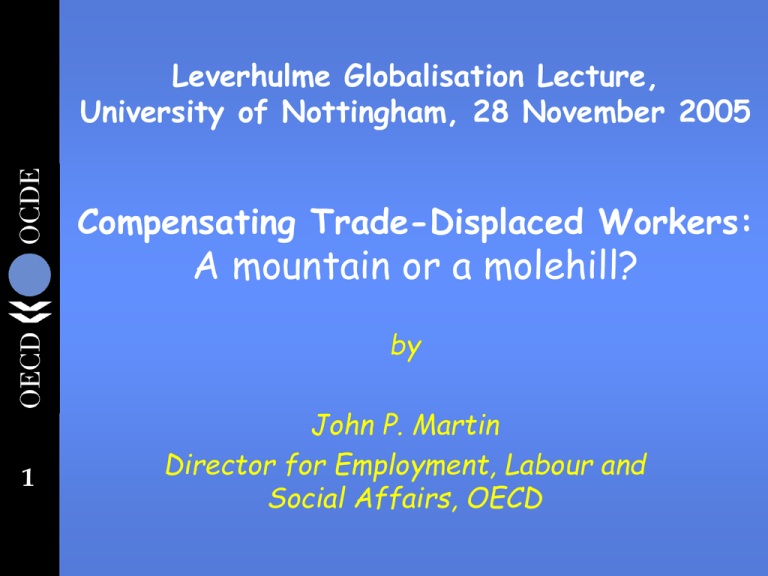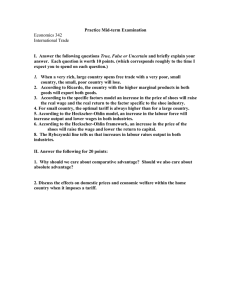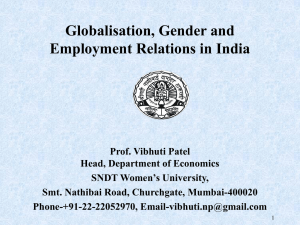John Martin , Director for Employment, Labour and Social Affairs, OECD, 'Compensating Trade-Displaced Workers: a Mountain or a Molehill?'
advertisement

Leverhulme Globalisation Lecture, University of Nottingham, 28 November 2005 Compensating Trade-Displaced Workers: A mountain or a molehill? by 1 John P. Martin Director for Employment, Labour and Social Affairs, OECD Outline of talk 2 The Issues Trade and OECD labour markets: the context Trade adjustment costs: the policy challenges Policy responses I. The Issues An old story: trade liberalisation creates winners and losers 3 Potential Pareto improvement if welfare gains exceed losses; actual Pareto improvement if the losers are compensated. But compensation often does not occur (or only partially) Why not? What might be desirable elements in a compensation strategy? II. The Current Context Why so much concern now about globalisation and labour markets? Rising imports of manufactured goods FDI in low-wage countries “Offshoring” of business services 4 - Chinese textiles today, but this is a long-running saga - Again, not a new story - High-skilled, white-collar workers are also at risk now, as well as low-skilled blue-collars Integration of China, India into the world trading system - Huge reservoirs of under-employed labour - Spectre of a “race to the bottom” What does the evidence say? 5 About the nature of international competition facing OECD workers About the impact of international competition on how OECD workers fare International competition is real International economic integration has increased dramatically - Trade flows have risen relative to GDP - FDI has also grown rapidly 6 And, it does threaten some jobs - Employment losses are observed in the industries facing the most intense international competition - International wage differentials are very large 7 Luxembourg Ireland Czech Republic Slovak Republic Belgium Hungary Netherlands Austria Denmark Switzerland Sweden Korea Portugal 1970-1974 Canada Turkey Iceland Finland Norway Mexico Germany Poland New Zealand Spain United Kingdom Italy France Greece Australia United States Japan STYLISED FACTS 1. Trade openness has increased in recent decades (“Openness” = exports plus imports of good and services as a proportion of domestic production) 2000-2004 300 250 200 150 100 50 0 STYLISED FACTS (cont.) 2. FDI « openness » has also increased Sum of inward and outward international direct investment positions as a percentage of GDP, 1990 and 2002 c 1990 2002 180 160 140 120 100 80 60 40 20 8 Source: OECD Economic Outlook , National Accounts and Foreign Direct Investment databases. Ireland Netherlands Switzerland Sweden United Kingdom Denmark Canada Finland Spain France Hungary Portugal New Zealand Germany Australia Norway Czech Republic Austria Slovak Republic United States Poland Italy Iceland Greece Japan 0 STYLISED FACTS (cont.) 3. Higher international competition is associated with lower employment growth at the industry level (annual percentage growth rate, 1980-2000) High-international-competition manufacturing Total manufacturing 20 10 0 -10 -20 -30 -40 -50 Spain Portugal Canada United States Sweden Australia Belgium Italy Japan Norway Austria Denmark France Finland United Kingdom 9 -60 Mexico Brazil Source: U.S. Bureau of Labor Statistics. Norway Denmark Germany Switzerland Belgium Netherlands United States Austria Sweden EU-15 Luxembourg Japan United Kingdom France Canada Australia OECD Ireland Italy Spain Israel Korea New Zealand Portugal Czech Republic 10 China India STYLISED FACTS (cont.) 4. Wage costs are far lower in the largest developing countries than in most OECD countries, 2002 [Costs = US$ at market exchange rates] 30 25 20 15 10 5 0 Important offsetting factors are often overlooked 11 Trade also generates jobs via exports “Offshoring” is not so threatening Trade has been a major driver of rising productivity and living standards The magnitude of trade-related adjustment costs: some evidence Gains from trade imply labour reallocation 12 But so do technological shocks, demographic shocks, etc. Labour reallocation implies displaced workers Need to balance compensation of displaced workers for their losses with adjustment from declining to expanding sectors Manufacturing workers are displaced more often than service workers, but evidence for a direct link between trade and job loss rates is mixed: Annual displacement rates Canada 1983-1999 Manufacturing 6.5 3.7 10.7 8.3 5.9 5.9 3.7 4.5 3.5 13.7 14.4 10.0 4.5 6.7 3.2 2.8 3.9 5.1 High-international-competition Medium-international-competition Low-international-competition Services and utilities Total employment 13 14 European United States countries 1994-2001 1979-1999 Industry The annual displacement rate is the share of workers experiencing a permanent, involuntary layoff during the year. Trade-displaced workers tend to be older, higher tenure, production workers: all characteristics associated with greater adjustment difficulties The United States, 1979-1999 Services 14 European countries, 1994-2001 All manufacturing High-import-competition manufacturing Ages 55-64 Job tenure >= 10 years Women Blue collar 14 Low education % 80 60 40 20 0 0 20 40 60 % 80 Trade-displaced workers bear adjustment costs: wage cuts are an important source of earnings losses in the US, while long-term joblessness plays a more important role in the EU The United States, 1979-1999 Services 14 European countries, 1994-2001 All manufacturing High-import-competition manufacturing Share of reemployed Mean change in log wage (x100) Share with earnings loss >30% 15 % 80 60 40 20 0 -20 -20 0 20 40 60 % 80 Rationales for Compensation/ Adjustment Assistance 3 rationales for policy intervention - Efficiency: Output is lower due to involuntary unemployment of trade-displaced workers; capital reallocation takes time 16 - Equity: Unfair that a minority of workers should lose from a policy that increases overall income (Corden’s “Conservative Social Welfare Function”) - Political economy: Political support for international economic integration presupposes adequate help for workers who are hurt Do these rationales create a strong case for compensating trade-displaced workers? First answer on both efficiency and equity grounds: No to a specific trade-related programme; Yes to a programme for all permanently displaced workers. 17 But there could be an exception on politicaleconomy grounds, as in U.S. What would a good compensation/adjustment scheme consist of for displaced workers? Need: Macroeconomic policies conducive to sustained growth and high employment. 18 Flexible labour and product markets An effective package of UI/active labour market policies (ALMPs) Effective lifelong learning polices Elements of an effective UI/ALMPs package Set replacement rates at reasonable levels and avoid open-ended duration of benefits Basic job-search services available to all job losers - Counselling/developing an individual plan - The advantage of an early start (advance notification of plant closures) - Be alert to indirect victims (e.g. long-term unemployed in a heavily impacted local labour market) Monitor effectively the job-search activity of jobseekers The watch words are “activation/mutual obligations” This can involve sanctions if individual job seekers do not live up to their side of the bargain - 19 Take steps to make work pay Among the range of ALMPs, make much greater use of those that work and phase out those that don’t Need more rigorous evaluations, especially in Europe Would it be useful to invest in wage insurance schemes for permanently displaced workers? Wage insurance: - Compensates for (part of) the wage losses on the new job (e.g. 50% of the difference in pay between the old and new jobs) - Recently introduced in France, Germany and the United States Unfortunately, no good evaluation evidence on whether wage insurance is a cost-effective instrument. - Serious design and implementation problems to be overcome. 20 Puzzle: Is wage insurance pertinent for European labour markets, where large wage cuts following re-employment are so rare? Maybe more so for the US? How do current and proposed compensation/ adjustment schemes for trade-displaced workers shape up? 1. TAA in the United States 21 Very long-standing; has been on the go since early 1960s. Has gone through many changes, most recently in 2002 when health care benefit, wage insurance component were added Procedures for certification under TAA very long and arbitrary Not many workers get extended UI benefits or reemployment services Main purpose is extended UI; political sop to freer trade How do current and proposed compensation/adjustment schemes for tradedisplaced workers shape up? (cont.) 2. Proposed EU Globalisation Adjustment Fund (GAF) Proposal made recently by EU Commission 22 aim is « to soften the negative impact of globalisation on laid-off workers and to improve their chances of finding new and better jobs by providing money for training and relocation ». Proposal extremely sketchy but it seems to imply « adjustment » rather than « compensation ». Motivation is a political-economy one Supported by Britain and France, but opposed by Germany, Sweden and some others. Not obvious that this is most needed for EU rather than more adaptable labour and product markets. EU Countries spend a lot on UI/ALMPs unlike the US(1) Total UI spending Millions of Euro 1 416 3 098 2 899 6 234 131 221 3 259 5 017 1 307 3 003 16 911 27 540 24 304 49 244 .. 631 1 582 1 231 .. 8 003 876 8 427 .. 1 863 31 350 1 670 85 93 5 326 11 002 464 3 261 8 288 5 819 Total ALMP spending Austria Belgium Czech Rep. Denmark Finland France Germany Greece Ireland Italy Netherlands Poland Portugal Slovak Rep. Spain Sweden United Kingdom Total 107 190 136 357 Total UI spending As a percentage of GDP 0.63 1.37 1.24 2.51 0.17 0.28 1.74 2.68 0.91 2.09 1.09 1.77 1.14 2.31 .. 0.41 1.17 0.91 .. 0.62 1.83 1.86 .. 1.08 0.67 1.28 0.29 0.32 0.72 1.48 1.29 1.22 0.53 0.37 Total ALMP spending 1.12 1. Data refer to 2003 23 Memorandum items Spending on TAA, 2003: USD 0.7 bill. Spending on UI benefits in the US, 2003: USD 41 bill. Spending on UI measures as % of U.S., GDP, 2003-04: 0.37 Spending on ALMPs measures as % of U.S., GDP, 2003-04: 0.16 1.42 Concluding thoughts The labour-market policy challenge from globalisation is real, but manageable - The goal: helping trade-displaced workers to re-integrate into productive employment - The means: a balanced package of largely familiar policies (e.g. good macro policy, flexible labour and product markets, effective activation of the unemployed via a package of UI/ALMPs/monitoring job-seeker behaviour/making work pay 24 Little justification for policies that explicitly target trade-displaced workers except on political economy grounds - This seems more pertinent for the U.S. context then for Europe. Bottom line: Europe needs to cut high and persistent unemployment in the major member states There are effective remedies, but how to mobilise the political will to implement them? Don’t make globalisation a scapegoat The US should invest more in an expanded 25 and more effective TAA in order to maintain the political economy case for trade liberalisation.






